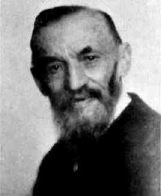

Giuseppe Peano went to Turin in 1870 for his secondary schooling, and in 1876, he entered the University of Turin. Peano continued to study pure mathematics, despite the fact that the rest of his classmates had switched to engineering after three years. Peano graduated as doctor of mathematics in 1880.
Peano joined the staff at the University of Turin in 1880. He published his first mathematical paper in 1880 and 3 more papers the following year. Peano was appointed assistant to Genocchi, who quite old and in relatively poor health, and so Peano took over some of his teaching.
In 1884, Genocchi published a book based on his lectures at Turin. This book, Course in Infinitesimal Calculus, was edited by Peano and contains much written by Peano himself.
Peano received his qualification to be a university professor in December 1884, and he continued to teach further courses, including some for Genocchi. Genocchi died in 1889, and in 1890 Peano was offered his post.
In 1886, Peano proved that if f(x,y) is continuous then the first order differential equation dy/dx = f(x,y) has a solution. The existence of solutions with
stronger hypothesis on functions had been given earlier by Cauchy, and then Lipschitz. Four years later Peano showed that the solutions were not unique, giving as an
example the differential equation dy/dx=3y2/3, with y(0) = 0.
In addition to his teaching at the University of Turin, Peano began lecturing at the Military Academy in Turin in 1886. The following year he published a method for solving systems of linear differential equations using successive approximations. In 1888, Peano published the book Geometrical Calculus, which begins with a chapter on mathematical logic. This was his first work on the topic that would play a major role in his research over the next few years. This book contains the first definition of a vector space given with a remarkably modern notation and style.
In 1889, Peano published his famous axioms, called the Peano axioms, which defined the natural numbers in terms of sets. These were published in a pamphlet which were at once a landmark in the history of mathematical logic and of the foundations of mathematics.
Peano also invented space-filling curves in 1890. It had been thought that such curves could not exist. Hausdorff wrote of Peano's result "This is one of the most remarkable facts of set theory".
In 1891 Peano founded a journal devoted mainly to logic and the foundations of mathematics. The first paper in the first part is a 10 page article by Peano summarizing his work on mathematical logic up to that time. Peano also had a great skill in seeing that theorems were incorrect by spotting exceptions.
From around 1892, Peano embarked on a new and extremely ambitious project, namely the Formulario Mathematico . This was intended to be the publication of collections of all the theorems now known that refer to given branches of the mathematical sciences.
In many ways this grand idea marks the end of Peano's extraordinary creative work. It was a project that was greeted with enthusiasm by a few and with little interest by most.
When the calculus volume of the Formulario Mathematico was published, Peano began to use it for his teaching. This was the disaster that one would expect. Peano, who was a good teacher when he began his lecturing career, became unacceptable to both his students and his colleagues by the style of his teaching. The project was completed in 1908, but although the work contained a mine of information, it was seldom used.
In 1903, Peano expressed interest in finding a universal, or international, language and proposed an artificial language based on Latin but stripped of all grammar. He compiled the vocabulary by taking words from English, French, German and Latin. The final edition of the Formulario Mathematico was written in this code, which is another reason the work was so little used.